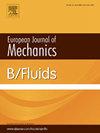Migration of a porous spherical particle in the presence of a non-deformable interface
IF 2.5
3区 工程技术
Q2 MECHANICS
引用次数: 0
Abstract
Semi-analytical solutions are obtained for a porous spherical particle moving in the presence of an interface separating two immiscible Newtonian fluids. The motion of the particle is considered for the following two cases: (a) quasi-steady translation perpendicular to the interface and (b) steady rotation about a diameter perpendicular to the interface. The porous medium within the particle is governed by the Brinkman equation with a tangential stress jump condition. The Capillary number is assumed to be small, which leads to negligible interface deformation. Using both cylindrical and spherical coordinates, general solutions for the Newtonian and Brinkman regions are constructed from basic solutions. Conditions are first satisfied at the bounding interface, followed by the application of the Fourier–Bessel transforms; then comes the application of the boundary conditions at the surface of the porous particle, which is handled by a collocation technique. The aim of this paper is to study and determine the effect of the bounding interface and the permeability of the Brinkman region on the drag force and torque acting on the porous particle. The drag force and torque coefficients are calculated with good convergence as functions of the dimensionless clearance distance between the porous particle and the bounding interface for the entire range of the dimensionless hydraulic permeability of the Brinkman medium, the stress jump factor, and the viscosity ratio between the fluid containing the particle and the fluid below the interface. Our collocation results are in good agreement with the available solutions in the literature for the limiting cases. The present study has potential applications in the fields of biomedical and industrial processes, such as the biophysics of membranes and porous agglomerates.
在不可变形界面的存在下多孔球形粒子的迁移
得到了在分离两种不混相牛顿流体的界面中运动的多孔球形粒子的半解析解。粒子的运动考虑以下两种情况:(a)垂直于界面的准稳态平移和(b)垂直于界面直径的稳态旋转。颗粒内部的多孔介质由具有切向应力跳变条件的布林克曼方程控制。假设毛细管数很小,可以忽略界面变形。使用柱坐标和球坐标,从基本解构造牛顿和布林克曼区域的一般解。首先在边界界面处满足条件,然后应用傅里叶-贝塞尔变换;然后是在多孔颗粒表面应用边界条件,这是通过配置技术处理的。本文的目的是研究和确定边界界面和布林克曼区的渗透率对作用在多孔颗粒上的阻力和扭矩的影响。在整个布林克曼介质的无因次水力渗透率范围内,以多孔颗粒与边界界面之间的无因次间隙距离、应力跳跃系数以及含颗粒流体与界面下流体之间的粘度比为函数,计算出的阻力系数和扭矩系数具有较好的收敛性。我们的配置结果与文献中关于极限情况的解很好地吻合。本研究在生物医学和工业过程领域具有潜在的应用前景,如膜和多孔团聚体的生物物理学。
本文章由计算机程序翻译,如有差异,请以英文原文为准。
求助全文
约1分钟内获得全文
求助全文
来源期刊
CiteScore
5.90
自引率
3.80%
发文量
127
审稿时长
58 days
期刊介绍:
The European Journal of Mechanics - B/Fluids publishes papers in all fields of fluid mechanics. Although investigations in well-established areas are within the scope of the journal, recent developments and innovative ideas are particularly welcome. Theoretical, computational and experimental papers are equally welcome. Mathematical methods, be they deterministic or stochastic, analytical or numerical, will be accepted provided they serve to clarify some identifiable problems in fluid mechanics, and provided the significance of results is explained. Similarly, experimental papers must add physical insight in to the understanding of fluid mechanics.

 求助内容:
求助内容: 应助结果提醒方式:
应助结果提醒方式:


